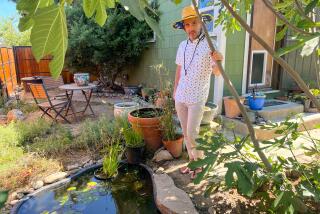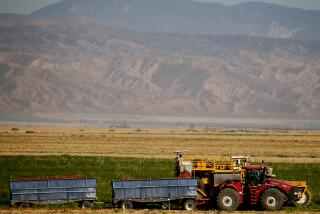Drought has made fountains a hard sell, but waterscape builders blame public misperception

- Share via
Yorba Linda business owner Jeffrey Barman has vowed that the state’s endless drought won’t mark the end of his company, California Waters.
Barman, co-owner Mark Pitman and some 45 employees design, install and repair decorative fountains and other water features, including a $3-million interactive fountain built for the Anaheim Convention Center in 2012. Despite a name that seems to court disaster in a dry region, California Waters managed to boost sales to about $6 million in the year that ended June 30, up 35% from two years earlier.
Still, four years of drought have made it “significantly harder to sell now,” Barman said. “What we don’t know about is the business we don’t get from people who would have called us before.”
The historic lack of rain has been rough on the state’s waterscape businesses — the people who create fountains, ponds and other aquatic landscape features. Such ornamental projects are easy targets when water is scarce, a scapegoating that fountain builders say is inaccurate and unfair.
“My fountain is still running,” said Denne Goldstein, publisher of Irrigation and Green Industry magazine, a Reseda-based trade publication for landscape and irrigation contractors.
Goldstein and others in the industry contend that modern fountains are getting a bum rap: They use efficient, energy-saving equipment; they are designed to minimize spraying or leaking into the ground; they recirculate water and in some cases rely on used water or captured rainfall.
The state’s drought action campaign “could have been handled much more intelligently” to keep owners from turning off fountains and going to other extremes that don’t save much water but hurt landscape companies and their employees, Goldstein said. “It makes me cringe.”
Although the waterscape niche is difficult to quantify, the overall landscape industry accounts for about $180 billion in sales a year, counting professionals and do-it-yourselfers, Goldstein said. Californians are among the biggest spenders on outdoor plants and landscape features, even those involving water, he said.
Public perception that water features are wasteful remains a big hurdle, waterscapers say.
“When designed and maintained correctly,” Barman said, “fountains require less water than any turf or grass. And the amount of water required to keep them going is minimal. They are better than any ‘hardscape’ alternative, like concrete that eventually has to be hosed down with water.”
Rick Baeza, owner of California Fountain Scapes in Castaic, tells customers that his recirculating fountains will lose less water from weeks of evaporation “than the amount of water used flushing the toilet at a restaurant.”
Another selling point, Baeza said, are calmer fountains that splash less, resulting in less evaporation.
Baeza is pinning his hopes on a few more storms before the El Niño weather system is done.
“I hope we get a good, long rain. Business has been slow. This has been affecting sales big time, for sure.”
Although California’s conservation rules allow fountains that use recirculating water, some officials remain unconvinced that fountains should flow freely. Some towns and water districts that allow fountains have used confusing language in setting their policies or have flip-flopped on whether fountains are allowed, manufacturers and installers say, which has befuddled potential customers.
Last year, Southern California’s Desert Water Agency, Rancho California Water District and Palm Springs City Council lifted bans on the use of decorative fountains, saying they didn’t represent a significant waste of water if they recirculate water.
SIGN UP for the free California Inc. business newsletter >>
But the debate may not be done, particularly if the drought persists.
Some board members of the Desert Water Agency, which serves Palm Springs, Desert Hot Springs and parts of Cathedral City, said repealing the ban sends the wrong message to Californians.
Craig Ewing, Desert Water Agency president, said at the time that the ban was “an important symbol that we are in a drought.”
Barman said that potential customers usually don’t even know what water district they are in, much less what the drought rules are.
Victor Hurtado, manager of Reseda Discount Fountains & Pottery, said he has long-term worries about the state’s increasingly dry climate.
“There are going to be problems because of this drought, and there seem to be no real answers or solutions for that,” he said.
California Waters has increased sales by adding construction services so that the company can handle all aspects from design through maintenance. The company also has won some high-profile commercial projects, including last year’s updating of the pumps, plumbing and filtration for Beverly Hills’ historic fountain at the corner of Santa Monica and Wilshire boulevards.
Still, the drought has taken a toll. “The biggest impact has been in our service division, where we have seen an unprecedented 15% drop in sales,” Barman said.
If El Niño ultimately doesn’t come through, Barman and co-owner Pitman have another plan: explore more sales in Utah and Arizona.
“They,” Barman said, “just don’t have all of the regulations we have.”
Twitter: @RonWLATimes
ALSO
Disney’s not alone in succession woes
Start-up TrueBill helps identify and cancel subscriptions you may not know you had
Will Napster co-founder Sean Parker’s Screening Room disrupt the film industry?
More to Read
Inside the business of entertainment
The Wide Shot brings you news, analysis and insights on everything from streaming wars to production — and what it all means for the future.
You may occasionally receive promotional content from the Los Angeles Times.











